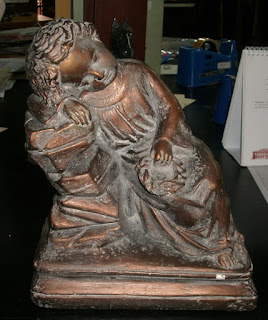Collectors Collection :- The cataloging of works.
by Isabelo Tampinco.
plaster cast.
As
I talked about in my last post, collectors must seriously consider
the longevity
of
their collections and the evolution of their collections.
Most serious collectors want their collections to live on after they
have passed on, so they must prepare their collections as if the
collection will go on for another one hundred years.
Many great art collectors have the attitude that it is a privilege to
be the custodians of a wonderful collection of fine art and that they
are keeping it safe for the generations to come.
As I wrote in my last post, two areas we have to consider are
Documentation of your collection and Legacy.
This post I want to look at Cataloging your collection, which is
quite different from Documentation. I will simply lay out how we
would do this if we were engaged to do the Cataloging a collection,
it will seem reasonably simply but some areas become more complicated
to compile than others.
Building the Catalog
1. NAME OF THE ARTIST.
Each artist in your collection must be listed in alphabetical order.
I
know that this seems logical and simple but I have seen cataloging
done under dates painted, birth dates of artists and date of
acquisition, some things can be simple but often they can be made
complicated.
2. HISTORY.
Each
painting or art work by the same artist is cataloged to the date of
completion, not date of purchase that will be recorded later. If
there
is no date of completion on the front or back of the painting then go
to your documentation to see if it is recorded on the Certificate of
Authenticity
or the purchase agreement. If this is unavailable then
approach the artist if they are alive, if not then search
books, gallery catalogs or seek out family members of the artist
who have an idea of the year of completion.
3.
REFERENCE.
Catalog must contain:-
- photos of the art work
- medium
- size of art work.
- size of frame.
- photo of signature and where it is placed.
- any distinguishing marks on the painting, front and back.
Some of this is repetition as photos of the art work and signatures
are also in your Documentation.
4. REFERENCE CARD.
On the back of the art piece a reference card would be attached, it
will contain:-
- Catalog number.
- Documentation number.
- Date of completion.
- Date of accusation.
5. CROSS REFERENCE.
The Catalog must cross reference with the Documentation and Legacy
easily.
This is necessary in the case of disposing of a piece or the need to
validate a piece, all needs to be numbered accordingly so that it can
easily come together.
Attention
to detail at the beginning certainly saves a lot of work and time
when trying later
to validate a piece of art.
6. CATALOG FOR DISPERSAL.
What if I decide to sell a painting that has the reference card
attached to the back, do I remove it?
No, as it will remain as proof of providence into the future and
have a connection back to your collection.
But
it would be necessary to take a photo of the card, so the new owner
can sign and date it as poof of the sale for you and purchase for
him, all part of the Documentation
of the work.
At
the point of sale you will need to copy all your Documentation
and Cataloging,
having the copies signed and dated by the new owner, so you can keep
a record of the sale and that painting will always have a connection
to your collection.
Because
a painting is sold and leaves your ownership you need to keep a copy
of all records for Providence
and to show the Evolution of your collection.
It
is very important in your catalog to have records of sold
paintings. Some collectors have a separate section for sold paintings
and all records are kept up to date. In
your Documentation, try to keep an up to date record of the painting
if it is sold again or is mentioned in press releases.
The Evolution of your collection is important as it will show how you
began and the changes that you made to your collection through
acquisitions and disposal of paintings.
Cataloging is done at the time of acquisition where as Documentation
and Legacy are upgraded continuously.
This is an overview of the process of Cataloging, a lot of tedious
work that will be invaluable to you in the future.
I do hope that this post has been of interest to you and helps you
with your collection.
Good collecting.
Mark E Shellshear.
Art Consultant.
markshellshear@gmail.com
Art Consultant.
markshellshear@gmail.com
" DON CRISOSTOMO "
Guillermo E Tolentino
cast marble...Manila 1948
19ins x 20ins h.


No comments:
Post a Comment